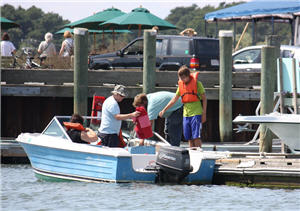
By Tom Keer for TakeMeFishing.org
 Every time I go fishing I expect to catch fish. Some days I catch a lot while other days I catch squat. Every time I go boating I expect to return to the dock. So far, that trend has held true and I’m thankful for it. And as there is time and effort that goes into catching fish there is time and effort that goes into boating safely. As the adage goes, “fail to plan, plan to fail.”
Every time I go fishing I expect to catch fish. Some days I catch a lot while other days I catch squat. Every time I go boating I expect to return to the dock. So far, that trend has held true and I’m thankful for it. And as there is time and effort that goes into catching fish there is time and effort that goes into boating safely. As the adage goes, “fail to plan, plan to fail.”
First, make sure you have enough life jackets for the individuals on board. There are different types of life jackets for different activities. The Safe Boating Campaign is a great resource for determining if a life jacket is right for you. Children, especially, should wear life jackets at all times when on board.
Secondly, make all maintenance for your boat and engine are up to date. I spoke with Capt. Curt Jessup, the owner of a Massachusetts marine assistance service called SeaTow Cape and Islands . His service directly rescues several hundred stranded boaters every year. I asked him for some insight into common issues that can be prevented.
“No matter how well you maintain your boat, engine, sails, and rigging, there is likely to be a time when they fail,” said Capt. Jessup. “Boaters who are properly prepared are most likely to come out of a bad situation unscathed. More importantly, they’re able to keep what is a normal situation, such as a non-working motor, from escalating into a life-threatening accident. While I have a laundry list of situations, here are some of the ones that regularly are at the top.”
- “The number one issue that jeopardizes a crew experiencing engine trouble is that they can’t stop their drift. Some boats aren’t equipped with the right anchor for their boating situation while others don’t have the appropriate length of line for the depths of their water. To resolve the issue, make sure you use a hook appropriate for your terrain as well as an appropriate length of line for your water’s depth. Claw or fluke anchors like Danforth’s are great for mud and sand bottoms while plough or Navy anchors are good choices for rocky or coral bottoms. I recommend boaters have between seven and nine feet of anchor rode per foot depth of water. An anchor that grabs will stop your boat from incurring additional damage should you lose power, and it can’t grab if you don’t have enough line.
- “A personal EPIRB is a great product to alert a rescue team of your location in the event of an emergency. Keep one in the pocket of your life vest and activate in an emergency.
- “A marine radio with a back up handheld radio is a good idea, as is having regular safety gear like flares, a whistle, a mirror, PFD’s, and even food, water, and fleece clothing or rain gear.
- “Consider enrolling in a marine assistance program that provides emergency coverage.”
Reviewing the Rules of the Road from sources like BoatUS is important when you’re under way. Knowing the difference between a nun, a can, a bell buoy, their colors, and who has the right of way is critical to avoiding an accident. Look at this picture for there are a number of violations. Here are some that I see:
- Leaving a wake in a no wake zone…inside the harbor.
- Motoring outside of the channel.
- Not following the red-right-return
- Most importantly no life jackets.
Tom Keer is an award-winning freelance writer who lives on Cape Cod, Massachusetts.
Visit him at www.tomkeer.com or at www.thekeergroup.com.
- 3858 views

